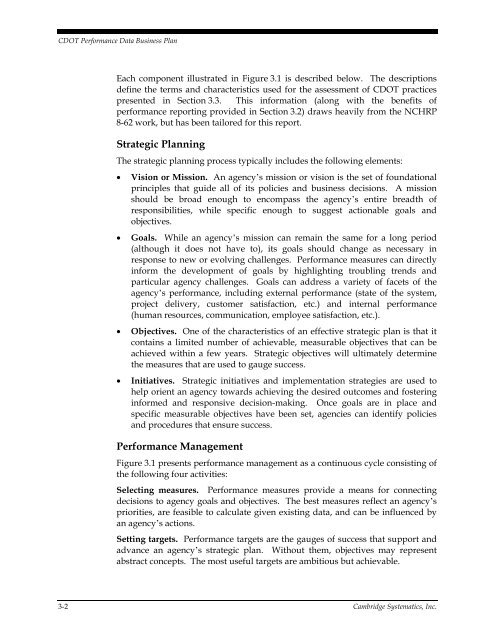CDOT Performance Data Business Plan - Cambridge Systematics
CDOT Performance Data Business Plan - Cambridge Systematics
CDOT Performance Data Business Plan - Cambridge Systematics
You also want an ePaper? Increase the reach of your titles
YUMPU automatically turns print PDFs into web optimized ePapers that Google loves.
<strong>CDOT</strong> <strong>Performance</strong> <strong>Data</strong> <strong>Business</strong> <strong>Plan</strong><br />
Each component illustrated in Figure 3.1 is described below. The descriptions<br />
define the terms and characteristics used for the assessment of <strong>CDOT</strong> practices<br />
presented in Section 3.3. This information (along with the benefits of<br />
performance reporting provided in Section 3.2) draws heavily from the NCHRP<br />
8-62 work, but has been tailored for this report.<br />
Strategic <strong>Plan</strong>ning<br />
The strategic planning process typically includes the following elements:<br />
<br />
<br />
<br />
<br />
Vision or Mission. An agency’s mission or vision is the set of foundational<br />
principles that guide all of its policies and business decisions. A mission<br />
should be broad enough to encompass the agency’s entire breadth of<br />
responsibilities, while specific enough to suggest actionable goals and<br />
objectives.<br />
Goals. While an agency’s mission can remain the same for a long period<br />
(although it does not have to), its goals should change as necessary in<br />
response to new or evolving challenges. <strong>Performance</strong> measures can directly<br />
inform the development of goals by highlighting troubling trends and<br />
particular agency challenges. Goals can address a variety of facets of the<br />
agency’s performance, including external performance (state of the system,<br />
project delivery, customer satisfaction, etc.) and internal performance<br />
(human resources, communication, employee satisfaction, etc.).<br />
Objectives. One of the characteristics of an effective strategic plan is that it<br />
contains a limited number of achievable, measurable objectives that can be<br />
achieved within a few years. Strategic objectives will ultimately determine<br />
the measures that are used to gauge success.<br />
Initiatives. Strategic initiatives and implementation strategies are used to<br />
help orient an agency towards achieving the desired outcomes and fostering<br />
informed and responsive decision-making. Once goals are in place and<br />
specific measurable objectives have been set, agencies can identify policies<br />
and procedures that ensure success.<br />
<strong>Performance</strong> Management<br />
Figure 3.1 presents performance management as a continuous cycle consisting of<br />
the following four activities:<br />
Selecting measures. <strong>Performance</strong> measures provide a means for connecting<br />
decisions to agency goals and objectives. The best measures reflect an agency’s<br />
priorities, are feasible to calculate given existing data, and can be influenced by<br />
an agency’s actions.<br />
Setting targets. <strong>Performance</strong> targets are the gauges of success that support and<br />
advance an agency’s strategic plan. Without them, objectives may represent<br />
abstract concepts. The most useful targets are ambitious but achievable.<br />
3-2 <strong>Cambridge</strong> <strong>Systematics</strong>, Inc.

















